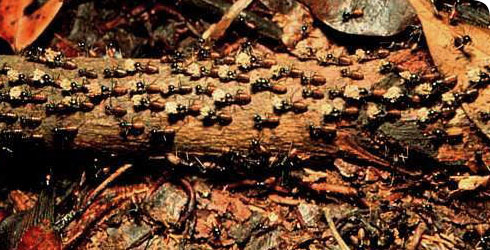Hospitalitermes hospitalis (processional termite)
Hospitalitermes are found across many parts of South-east Asia, where they live in rainforests.
It is 1 of only a handful of genera in which the species forage in processional columns in the open-air. Up to half a million individuals from a colony can be involved in a single foraging expedition.
Soldier and worker termites leave their nest in the late afternoon. They march in column formation across the forest floor to a canopy tree where they graze throughout the night on lichens and other tiny plants growing high up on the trunk.
In 2007, molecular evidence was published confirming that termites evolved from cockroaches.
Species detail
-

Taxonomy
Read on to discover how soldiers of Hospitalitermes hospitalis use a chemical weapon to defend the colony from attack.
-

Biology
Termites are social insects that divide tasks among different castes. Read on to discover how the Hospitalitermes hospitalis soldier termites use a chemical weapon to defend the colony from attack.
-

Distribution and ecology
Hospitalitermes are found across South-east Asia, southern China and Indonesia. They are distinct from most other termite genera because they forage in processional columns and feed on living plants in the rainforest canopy. Discover how they transport balls of food back to their nest.
-

References
Get reference material for Hospitalitermes hospitalis.
Images

Some species of Hospitalitermes nest on the ground or between the roots of big trees. However, some species build arboreal nests (the black material) among epiphytes in the forest canopy. Lambir Hills National Park, Sarawak, Borneo.
© David T Jones
Hospitalitermes lividiceps is closely related to H. hospitalis but the soldiers have a distinct orange coloured head. From Lambir Hills National Park in Sarawak, Borneo.
© Chihiro Handa
Hospitalitermes medioflavus has very similar foraging behaviour to H. hospitalis. In this image (a) the smaller workers (indicated with red arrows) are gnawing at the tree bark.
© Toru Miuru
Hospitalitermes medioflavus has very similar foraging behaviour to H. hospitalis. In this image (b), after gnawing food from the bark, a small worker (indicated with red arrow) can be seen passing the food to a larger worker (indicated with black arrow) who will carry the ball of food back to the nest.
© Toru Miura
One of several entrance holes to a nest of Hospitalitermes medioflavus, built against the base of a tree in Kalimantan, Borneo. Soldiers stand guard around the inner edge of the entrance (which is about 2cm wide).
© Toru MiuraAbout the author

Dr David T Jones
Research Associate
Department of Entomology
Research interests include termites, earthworms, soil biodiversity and rainforest ecology
A word from the author
"If you go walking in a South-east Asia rainforest in the morning, you are likely to see a column of processional termites crossing your path. At first glance you might think they’re ants. But if you look closely, you will see the chemical squirt gun on the head of the soldiers as they guard the workers. It’s fascinating to watch the endless stream of workers rushing back to the nest carrying balls of food. If you have the time, carefully follow the column and you will locate the nest."
